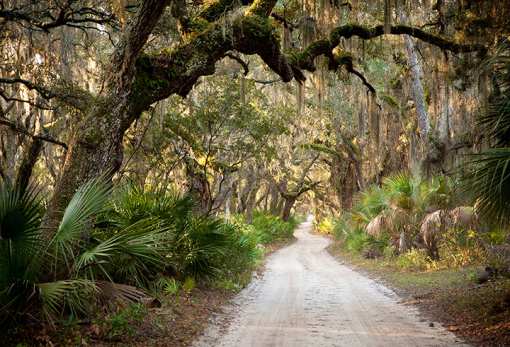History of the St. Simons Lighthouse
The First Lighthouse (1810)
On October 17, 1804, John Couper, a plantation owner on St. Simons Island, deeded four acres of his land, known as "Couper's Point," at the south end of the island for one dollar to the Federal government for the construction of a lighthouse. James Gould of Massachusetts was hired in 1807 by the Treasury Department to build the lighthouse and a one-story frame residence. Original specifications called for the lighthouse to be built of hard brick; however, for economic purposes, most of the material used in the construction was "tabby," a mixture of oyster shell, lime, sand, and water. The uppermost part (12_ feet) was constructed of the "best northward brick." The 75-foot tower, exclusive of the lantern, was an octagonal pyramid, 25 feet in diameter at the base, tapering to 10 feet in diameter at the top. The tabby foundation was eight feet thick at the base. An iron lantern ten feet high and eight feet in diameter rested on top of the brick and tabby tower, making the lighthouse 85 feet tall. Oil lamps were suspended on iron chains in the lantern.
Appointed in May 1810 by President Madison as the first keeper, James Gould held this position at an annual salary of $400 until his 1837 retirement. In 1857, a third-order, double-convex Fresnel lens was installed that greatly improved the lighthouse's power and range. During the Civil War, the Macon Artillery troops and six field guns were stationed at Fort Brown to protect St. Simons Sound. In February 1861, Alexander Couper, son of John Couper, wrote to his brother, James, "I went down to the Island to the officers at 'Fort Brown'--they are comfortably situated in thatched camps. They have built two angles of eighteen-feet base as a breast work. The Fort lies just west of the lighthouse in a corner of Mr. King's field." (The Kings were the owners of Retreat Plantation, now the Sea Island Golf Club and Lodge)
During the Civil War, the blockade of Federal ships and the subsequent invasion of Georgia by Federal troops forced the Confederates to evacuate St. Simons Island. Prior to leaving in 1862, the Confederates destroyed Gould's lighthouse so the Federal forces could not use it as a navigational aid. For the next ten years, Retreat Plantation's cotton barn served as a navigational reference for ships entering Brunswick harbor. The tall cotton barn was marked on U.S. government maps as "King's Cotton House."
The ruins of the first lighthouse were partially excavated by archaeologists during August 1974. Its boundaries are just south of the oil house where one can see a mound of grass. A photograph and history are explained on an interpretative sign at that spot. James Gould probably built a frame house to serve as the home for the lighthouse keeper and his family. The exact site of that dwelling is not known.
St. Simons Island Lighthouse Museum Statement of Purpose
The mission of the St. Simons Island Lighthouse Museum is to present and interpret the history and culture of coastal Georgia as it is reflected in its heritage of significant sites and resources. Through exhibits, educational programs and interpretation, the value of this heritage gives meaning and orientation to present day life and creates an awareness of the need for the preservation of our treasured past for future generations.
The Coastal Georgia Historical Society statement of purpose and St. Simons Island Lighthouse Museum mission were officially adopted by the Executive Board of Director and incorporated into the By-Laws, amended 14 December 2000.






